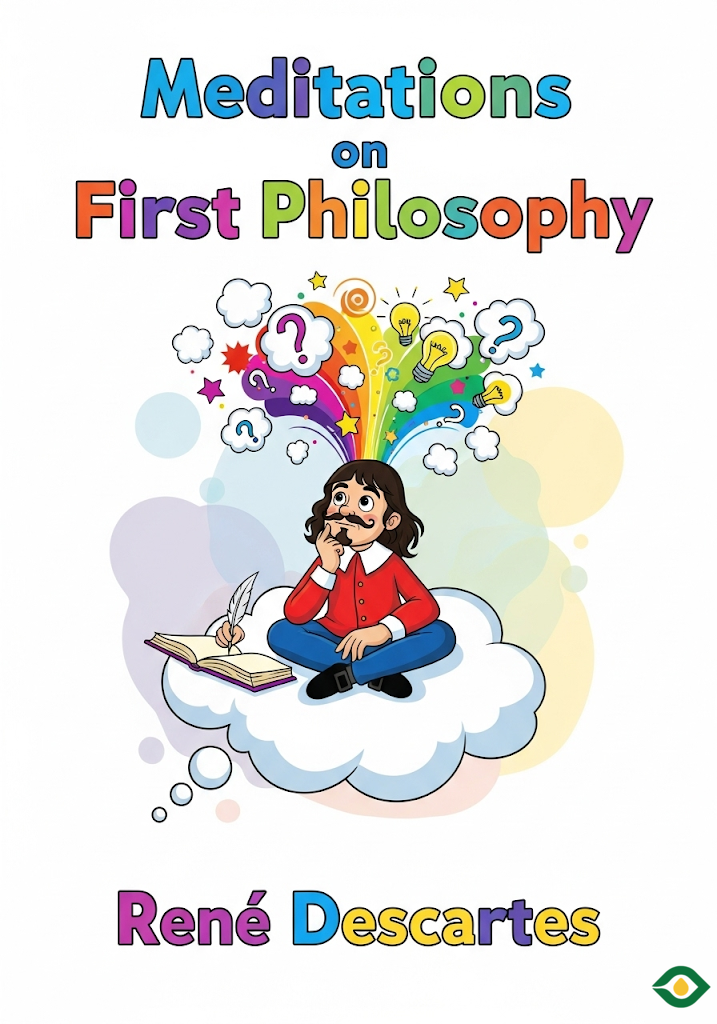Description
René Descartes’ Meditations on First Philosophy is one of the most famous works in the history of philosophy. In this book, he explores the nature of truth, existence, and the difference between mind and body. His most famous phrase, “I think, therefore I am,” comes from this work. But the book goes far beyond that line. It tries to answer a simple but deep question: what can we really know for certain?
At the beginning, Descartes decides to doubt everything he has ever believed. He notices that his senses often deceive him. For example, when he looks at objects from far away, they appear smaller than they truly are. When he dreams, the dreams feel real, yet they are illusions. Even paintings can trick the mind into seeing things that do not exist. If our senses can mislead us so easily, how can we rely on them for truth?
To push the point further, Descartes imagines the possibility of a powerful deceiver, like an “evil genius,” who might be controlling his experiences. If such a being existed, then everything he sees, hears, or touches might be false. This thought experiment shows how fragile our trust in the outside world can be. He uses this extreme doubt not to despair, but to find something that cannot be shaken by doubt.
That unshakable truth comes from the act of thinking itself. Even if a deceiver tries to trick him, he still must exist to be deceived. The very act of questioning, doubting, or reasoning proves that there is a mind doing the thinking. This leads to his famous conclusion: “I think, therefore I am.” Unlike the senses, which can be fooled, the mind’s awareness of its own thinking cannot be doubted.
From here, Descartes explores how we understand objects and ideas. He uses the example of a piece of beeswax. When freshly taken from a hive, beeswax has a certain smell, shape, and feel. But if placed near fire, the beeswax melts. Its smell, shape, and texture all change. Yet, even though its sensory qualities shift, the mind recognizes that it is still beeswax. This shows that our knowledge of things does not come from the senses alone, but from the mind’s power to judge and interpret.
He then considers how ideas exist in our minds. Some ideas come from the outside world, such as the feeling of heat or the sound of music. Others are created by our imagination, such as mythical creatures like centaurs or satyrs. But there are also ideas that seem to be built into us, such as mathematical truths or the concept of perfection. We can imagine triangles, circles, and numbers without ever seeing them in physical form. This suggests that certain knowledge is not learned through the senses but is innate in human reason.
This leads Descartes to his discussion of God. He argues that the very idea of God could not have come from his limited, imperfect self. The concept of an infinite, all-perfect being must have been placed in his mind by something that truly has those qualities. In other words, God must exist because only a being greater than humans could give them the idea of perfection and infinity. Just as fire gives warmth, the idea of God’s perfection could only come from a perfect source.
For Descartes, God also serves as the guarantee of truth. If God exists and is perfect, then He would not deceive humans about the basic structure of reality. This allows Descartes to rebuild knowledge. Once God’s existence is established, he can trust that the mind was designed to think correctly, and that clear and distinct ideas reflect reality.
The final part of his meditation deals with the relationship between mind and body. Descartes makes a sharp distinction between the two. The mind, or soul, is a thinking thing. It has no shape, no size, and no physical properties. It can exist independently of the body. The body, on the other hand, is a physical thing. It has weight, extension, and form. It operates in the physical world and is subject to change and decay.
He argues that the mind is known with greater certainty than the body. The body might be doubted because the senses might mislead us, but the existence of thought is undeniable. This means the mind is a higher form of reality. Since they are separate, it is possible that the soul could live on even after the body dies.
By the end of Meditations on First Philosophy, Descartes has built a structure of knowledge starting from absolute doubt. He showed that:
Senses cannot be fully trusted.
The mind’s act of thinking proves our existence.
Ideas exist in different forms, some from experience, some from imagination, and some from reason itself.
The idea of God points to the existence of a perfect being.
Mind and body are distinct, and the soul can exist without the body.
The importance of this book lies not only in the arguments themselves but also in the method Descartes used. His way of starting from doubt and building up knowledge step by step shaped the future of philosophy and science. Instead of relying on authority or tradition, he searched for certainty through reason.
This work also influenced later debates about the nature of the mind, the limits of knowledge, and the relationship between humans and God. The phrase “I think, therefore I am” is remembered as a simple yet profound expression of human existence. But Descartes’ meditations go much further, challenging us to think carefully about what we know, how we know it, and what it means to be alive and aware.
In the end, Meditations on First Philosophy is a journey inward. It is about stripping away illusions, questioning appearances, and finding the one thing that cannot be doubted: the fact that we are thinking beings. From this starting point, Descartes rebuilds a vision of reality that includes the self, the world, and God. His book remains a cornerstone of philosophy because it asks the timeless question: What can we truly know for certain?





